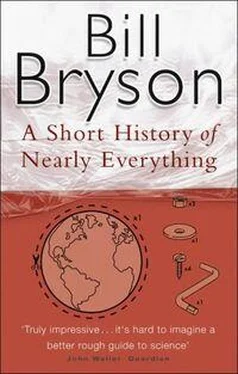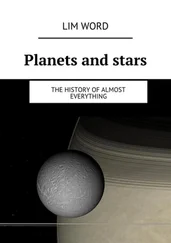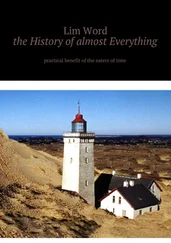Then come Lyell’s epochs-the Pleistocene, Miocene, and so on-which apply only to the most recent (but paleontologically busy) sixty-five million years, and finally we have a mass of finer subdivisions known as stages or ages. Most of these are named, nearly always awkwardly, after places: Illinoian, Desmoinesian, Croixian, Kimmeridgian, and so on in like vein. Altogether, according to John McPhee, these number in the “tens of dozens.” Fortunately, unless you take up geology as a career, you are unlikely ever to hear any of them again.
Further confusing the matter is that the stages or ages in North America have different names from the stages in Europe and often only roughly intersect in time. Thus the North American Cincinnatian stage mostly corresponds with the Ashgillian stage in Europe, plus a tiny bit of the slightly earlier Caradocian stage.
Also, all this changes from textbook to textbook and from person to person, so that some authorities describe seven recent epochs, while others are content with four. In some books, too, you will find the tertiary and quaternary taken out and replaced by periods of different lengths called the Palaeogene and Neogene. Others divide the Precambrian into two eras, the very ancient Archean and the more recent Proterozoic. Sometimes too you will see the term Phanerozoic used to describe the span encompassing the Cenozoic, Mesozoic, and Paleozoic eras.
Moreover, all this applies only to units of time . Rocks are divided into quite separate units known as systems, series, and stages. A distinction is also made between late and early (referring to time) and upper and lower (referring to layers of rock). It can all get terribly confusing to nonspecialists, but to a geologist these can be matters of passion. “I have seen grown men glow incandescent with rage over this metaphorical millisecond in life’s history,” the British paleontologist Richard Fortey has written with regard to a long-running twentieth-century dispute over where the boundary lies between the Cambrian and Ordovician.
At least today we can bring some sophisticated dating techniques to the table. For most of the nineteenth century geologists could draw on nothing more than the most hopeful guesswork. The frustrating position then was that although they could place the various rocks and fossils in order by age, they had no idea how long any of those ages were. When Buckland speculated on the antiquity of an Ichthyosaurus skeleton he could do no better than suggest that it had lived somewhere between “ten thousand, or more than ten thousand times ten thousand” years earlier.
Although there was no reliable way of dating periods, there was no shortage of people willing to try. The most well known early attempt was in 1650 when Archbishop James Ussher of the Church of Ireland made a careful study of the Bible and other historical sources and concluded, in a hefty tome called Annals of the Old Testament , that the Earth had been created at midday on October 23, 4004 B.C., an assertion that has amused historians and textbook writers ever since. [9]
There is a persistent myth, incidentally-and one propounded in many serious books-that Ussher’s views dominated scientific beliefs well into the nineteenth century, and that it was Lyell who put everyone straight. Stephen Jay Gould, in Time’s Arrow, cites as a typical example this sentence from a popular book of the 1980s: “Until Lyell published his book, most thinking people accepted the idea that the earth was young.” In fact, no. As Martin J. S. Rudwick puts it, “No geologist of any nationality whose work was taken seriously by other geologists advocated a timescale confined within the limits of a literalistic exegesis of Genesis.” Even the Reverend Buckland, as pious a soul as the nineteenth century produced, noted that nowhere did the Bible suggest that God made Heaven and Earth on the first day, but merely “in the beginning.” That beginning, he reasoned, may have lasted “millions upon millions of years.” Everyone agreed that the Earth was ancient. The question was simply how ancient.
One of the better early attempts at dating the planet came from the ever-reliable Edmond Halley, who in 1715 suggested that if you divided the total amount of salt in the world’s seas by the amount added each year, you would get the number of years that the oceans had been in existence, which would give you a rough idea of Earth’s age. The logic was appealing, but unfortunately no one knew how much salt was in the sea or by how much it increased each year, which rendered the experiment impracticable.
The first attempt at measurement that could be called remotely scientific was made by the Frenchman Georges-Louis Leclerc, Comte de Buffon, in the 1770s. It had long been known that the Earth radiated appreciable amounts of heat-that was apparent to anyone who went down a coal mine-but there wasn’t any way of estimating the rate of dissipation. Buffon’s experiment consisted of heating spheres until they glowed white hot and then estimating the rate of heat loss by touching them (presumably very lightly at first) as they cooled. From this he guessed the Earth’s age to be somewhere between 75,000 and 168,000 years old. This was of course a wild underestimate, but a radical notion nonetheless, and Buffon found himself threatened with excommunication for expressing it. A practical man, he apologized at once for his thoughtless heresy, then cheerfully repeated the assertions throughout his subsequent writings.
By the middle of the nineteenth century most learned people thought the Earth was at least a few million years old, perhaps even some tens of millions of years old, but probably not more than that. So it came as a surprise when, in 1859 in On the Origin of Species , Charles Darwin announced that the geological processes that created the Weald, an area of southern England stretching across Kent, Surrey, and Sussex, had taken, by his calculations, 306,662,400 years to complete. The assertion was remarkable partly for being so arrestingly specific but even more for flying in the face of accepted wisdom about the age of the Earth. [10]It proved so contentious that Darwin withdrew it from the third edition of the book. The problem at its heart remained, however. Darwin and his geological friends needed the Earth to be old, but no one could figure out a way to make it so.
Unfortunately for Darwin, and for progress, the question came to the attention of the great Lord Kelvin (who, though indubitably great, was then still just plain William Thomson; he wouldn’t be elevated to the peerage until 1892, when he was sixty-eight years old and nearing the end of his career, but I shall follow the convention here of using the name retroactively). Kelvin was one of the most extraordinary figures of the nineteenth century-indeed of any century. The German scientist Hermann von Helmholtz, no intellectual slouch himself, wrote that Kelvin had by far the greatest “intelligence and lucidity, and mobility of thought” of any man he had ever met. “I felt quite wooden beside him sometimes,” he added, a bit dejectedly.
The sentiment is understandable, for Kelvin really was a kind of Victorian superman. He was born in 1824 in Belfast, the son of a professor of mathematics at the Royal Academical Institution who soon after transferred to Glasgow. There Kelvin proved himself such a prodigy that he was admitted to Glasgow University at the exceedingly tender age of ten. By the time he had reached his early twenties, he had studied at institutions in London and Paris, graduated from Cambridge (where he won the university’s top prizes for rowing and mathematics, and somehow found time to launch a musical society as well), been elected a fellow of Peterhouse, and written (in French and English) a dozen papers in pure and applied mathematics of such dazzling originality that he had to publish them anonymously for fear of embarrassing his superiors. At the age of twenty-two he returned to Glasgow University to take up a professorship in natural philosophy, a position he would hold for the next fifty-three years.
Читать дальше












